The Real Reward
On fame, influence, and the power of recognition in science.

Read Time: 3 minutes
Published:
It is rare for scientists to become famous. For some, fame came when they captured the zeitgeist with their ideas. For example, Heisenberg’s “uncertainty principle” resonated in an age of psychological uncertainty. For others, it is work that is ancillary to their actual science that brings fame. Robert Oppenheimer was a public figure less for his scientific work on the structure of subatomic particles than for leading the Manhattan Project and the development of the atom bomb during war time. Watson and Crick became famous not only for describing the chemical basis of heredity—beginning a biological revolution—but also for delivering a beautiful, odd, unfamiliar term in science, double helix—the structure of DNA—to a wider audience.
Fame in science, then, depends on timing and circumstances and how a scientist’s work touches society. Far more common, it is the work that is recognized, not the person. Recognition comes principally from other scientists building on a scientist’s ideas, giving them life well past that of the original work.
[I]deas are meant to triumph not because of who is advocating for them but because they seem to explain the data better than other ideas.
This recognition is a bonus that comes along with a new and interesting scientific discovery. Sometimes there are riches that follow for a scientist whose discovery leads to a product that does well in the marketplace. But paradoxically, it is the giving away of one’s work freely into the public domain that establishes its owner and creates value. Only after groups of scientists scrutinized and accepted the work announcing that a coronavirus was the cause of a new pandemic did a consensus name emerge: COVID-19. As historian of science Robert Merton wrote decades earlier, “There is no such thing as a scientific truth believed by one person and disbelieved by the rest of the scientific community; an idea becomes a truth only when a vast majority of scientists accept it without question.”
But recognition for new and important work is not a given. Eminent scientists get disproportionately greater credit for their contributions than lesser known scientists who make comparable contributions, according to a study of Nobel laureates. There is social stratification in science. But there is unfairness too. There are any number of distinguished scientists who have not had the acknowledgment of the Nobel Prize for their important discoveries: think of Jonas Salk and Albert Sabin, developers of the first effective vaccines against poliomyelitis, and of Richard Doll and Richard Peto, who established the relationship between cigarette smoking and lung cancer.
If recognition comes in the form of citations in work by others, the prior reputation of authors advances the speed of diffusion of their findings. Yet ideas are meant to triumph not because of who is advocating for them but because they seem to explain the data better than other ideas. “That is, after all, what we mean by the expression ‘scientific contribution’: an offering that is accepted, however provisionally, into the common fund of knowledge,” wrote Merton.
In our celebrity-filled and speedy world, it is increasingly rare for a scientist to become a household name. But fame is not the same as influence, and at the end of the day influence may be what matters most. Science is deeply technical, and fame emerges from forces outside the robustness of the actual contribution any one scientist is making. Recognition by peers, credit for providing a greater understanding of the world, is the real reward.
Previously in Observing Science: Speaking Out




